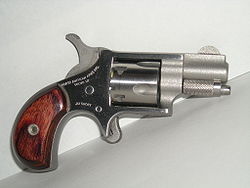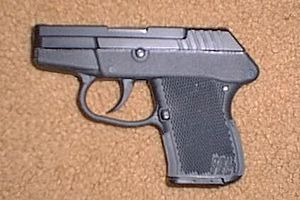- Mousegun
-
A mousegun is most often considered a category of small revolver, or semi-automatic handgun intended for self defense. Typically such small pistols are of .380 ACP (9mm Short) caliber or less, with .32 ACP and .22 Long Rifle calibers also being common. The term is used to describe a class of small handguns. The term is also sometimes used to refer to rifles firing bullets smaller than .30 caliber, such as the .223/5.56mm.
Contents
Terminology
Among mousegun users, the term mousegun itself is not usually considered to be pejorative, but is instead affectionately used. Manufacturers of these guns however generally label them as "ultra-compact", avoiding the derogatory connotation given by users of larger-caliber, larger-size guns, and also differentiating them from "sub-compact" models such as the Glock 26 and 36, which have a similar role of deep concealment, but fire larger "defense caliber" cartridges between 9x19mm Parabellum and .45 ACP and are therefore slightly larger themselves.
Those who favor larger, heavier handguns (not necessarily of larger caliber) do often use the term mousegun for any small caliber firearm in a disparaging way, generally for guns they see as intended for use in a military or self defense role where power should be considered more important.
Among those who prefer larger, heavier guns, the term mousegun is sometimes applied to junk guns, especially those in .22 Long Rifle or .25 ACP.
Among those who prefer larger, heavier guns, it is noteworthy to realize that .22 caliber pistols (and even rifles) that are intended for target shooting, plinking, or small game hunting are not considered mouseguns. In this usage, there is widespread agreement, even among those who favor the use of mouseguns for use in deeply-concealed carry; full-size handguns and rifles, despite firing small caliber bullets, are not mouseguns.
Pistol mouseguns
In order to create such small pistols, engineering compromises need to be made, and many mouseguns lack features such as slide stops and external safeties, and few function quite as reliably as refined, full-size designs such as the M1911. The small size and mass of the pistol, and low energy of the cartridge, also can make functioning of semi-automatic versions less reliable. With the short sight radius, and low-profile, snag-resistant iron sights, which are required for meeting the needs for a deeply-concealed handgun, these guns are also difficult to shoot accurately over longer distances; over distances of only 3-7 yards (2.7 - 6.4 m), they can serve.
Despite the marginal power, many people carry mouseguns for defense, on the premise that a weak pistol you can easily carry/conceal is far better than a powerful gun you leave at home (because it cannot be easily carried/concealed). A mousegun is often the gun carried when one is carrying a deeply-concealed handgun, or it is the gun carried when one is ostensibly, by all appearances, not carrying. Additionally, the engineering required to build such a small handgun is admired by many, and there are thus many people who enjoy collecting and shooting mouseguns.
Examples of such mouseguns include the Seecamp, the North American Arms Guardian and Mini Revolvers (such as the Black Widow), the Kel-Tec P32 (.32 caliber) and P3-AT (.380 caliber), the Ruger LCP (.380 caliber), the Beretta Bobcat (.22 or .25 caliber), Jetfire (.25 caliber), and Tomcat (.32 caliber). Slightly larger 9 mm mouseguns, still under 16 ounces (450 g) in weight, and very small in size, include the Kel-Tec P11 and PF-9, the Smith and Wesson PC 945 Micro, Kahr Arms PM9, and the Rohrbaugh R9. The Rohrbaugh R9 is currently the smallest 9 mm pistol on the market, replacing the Kel-Tec P11 which formerly held that distinction. All of these mouseguns conceal especially well. Mousegun-pistols using .45 exist too; examples include the Kahr PM45 and Para-Ordnance p6.45 and p10.45. When firing these weapons, one should however expect quite a kick due to their high power/weight ratio.
Law enforcement mousegun users typically choose guns in either 380 ACP or 9 mm, depending on the rules set by each department for backup guns. Often, the requirement is that the backup gun has to be in the same caliber as the main service pistol, for ammunition compatibility.
Revolver mouseguns
 North American Arms model NAA22S mini-revolver, chambered in .22 Short.
North American Arms model NAA22S mini-revolver, chambered in .22 Short.
Examples of revolver mouseguns include the North American Arms Mini Revolver, which is a spur trigger design with birdshead grips. The North American Arms Mini Revolver is styled very much like popular pocket revolvers of the 19th Century, but is made entirely of stainless steel.
Smith & Wesson's "J-Frame" series of revolvers are a common choice for mouseguns. They are generally more reliable than their automatic counterparts, and offer an exceptional power-to-weight ratio, especially the lightweight AirLite and Airweight lines. On the other hand, they offer only five shots (auto mouseguns often hold more rounds), and have considerably greater recoil, especially in .357 magnum.
Historical perspective
Particularly small and high-quality examples, such as the Seecamp LWS 32 .32 ACP pistol, formerly commanded prices significantly higher than its US$600 retail. During the mid 1990s, demand so far exceeded supply that contracts for guns were sold up to two years before the guns themselves were produced, and the guns themselves were then often resold for as much as $1100 USD upon delivery.
Since roughly 1995, however, there has been considerable erosion in these high mousegun prices, no doubt a result of Kel-Tec starting to produce a 9 mm mousegun, the Kel-Tec P11, then the .32 ACP P-32(~$230) and the .380 ACP P3AT(~$260), all of which were priced at roughly half the price of the Seecamp LWS, while packaged in much the same size.
Rifle mouseguns
When the M16 was first introduced, it was sometimes called a "mousegun" for firing a .223" diameter bullet instead of the earlier .30 caliber bullet used in US Military rifles for many decades.
See also
References
External links
Categories:- Handguns
Wikimedia Foundation. 2010.

